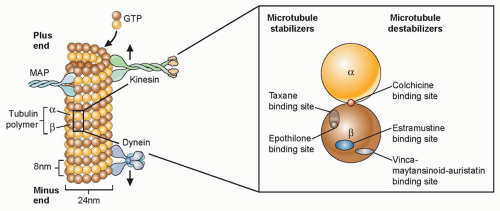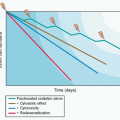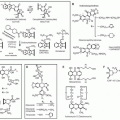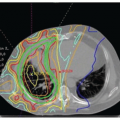Chemotherapeutic Agent |
Dosage |
Indications |
Common Toxicities |
Paclitaxel |
135-200 mg/m2 IV over 3 h or 135 mg/m2 IV over 24 h every 3 wk; or 80 mg/m2 IV over 1 h weekly |
Adjuvant therapy of node-positive breast cancer; metastatic breast, ovarian, non-small-cell lung, bladder, esophagus, cervical, gastric, and head and neck cancer; AIDS-related Kaposi sarcoma; cancer of unknown origin |
Myelosuppression, hypersensitivity, nausea and vomiting, alopecia, arthralgia, myalgia, peripheral neuropathy |
Docetaxel |
60-100 mg/m2 IV over 1 h every 3 wk |
Adjuvant therapy of node-positive breast cancer; metastatic breast, gastric, head and neck, prostate, non-small-cell lung, and ovarian cancer |
Myelosuppression, hypersensitivity, edema, alopecia, nail damage, rash, diarrhea, nausea, vomiting, asthenia, neuropathy |
Cabazitaxel |
25 mg/m2 IV every 3 wk over 1 h |
Docetaxel-refractory metastatic castration resistant prostate cancer |
Neutropenia, infections, myelosuppression, diarrhea, nausea, vomiting, constipation, abdominal pain, asthenia |
Nab-paclitaxel |
260 mg/m2 IV over 30 min every 3 wk; or 125 mg/m2 IV weekly on days 1, 8, and 15 every 28 d |
Metastatic breast cancer, non-small-cell lung cancer, pancreatic cancer |
Myelosuppression, nausea, vomiting, alopecia, myalgia, peripheral neuropathy |
Ixabepilone |
40 mg/m2 IV over 3 h every 3 wk |
Metastatic and locally advanced breast cancer |
Myelosuppression, fatigue/asthenia, myalgia/arthralgia, alopecia, nausea, vomiting, stomatitis/mucositis, diarrhea, musculoskeletal pain |
Vincristine |
0.5-1.4 mg/m2/wk IV (maximum 2 mg per dose); or 0.4 mg/d continuous infusion for 4 d |
Lymphoma, acute leukemia, neuroblastoma, rhabdomyosarcoma, AIDS-related Kaposi sarcoma, multiple myeloma, testicular cancer |
Constipation, nausea, vomiting, alopecia, diplopia, myelosuppression |
Vinblastine |
6 mg/m2 IV on days 1 and 15 as part of the ABVD regimen; 0.15 mg/kg IV on days 1 and 2 as part of the PVB regimen; 3 mg/m2 IV as part of days 2, 15, 22 MVAC regimen |
Hodgkin and non-Hodgkin lymphoma; Kaposi sarcoma; breast, testicular, bladder, prostate, and renal cell cancer |
Myelosuppression, constipation, alopecia, malaise, bone pain |
Vinorelbine |
25-30 mg/m2 IV weekly |
Non-small-cell lung, breast, cervical, and ovarian cancer |
Alopecia, diarrhea, nausea, vomiting, asthenia, neuromyopathy |
Estramustine |
14 mg/kg PO daily in 3 or 4 divided doses |
Metastatic prostate cancer |
Nausea, vomiting, gynecomastia, fluid retention |
Ado-trastuzumab emtansine |
3.6 mg/kg IV every 3 wk |
Metastatic breast cancer |
Thrombocytopenia, nausea, constipation or diarrhea, peripheral neuropathy, fatigue, increased AST/ALT |
Brentuximab vedotin |
1.8 mg/kg every 3 wk, maximum dose 180 mg |
Refractory Hodgkin lymphoma, refractory systemic anaplastic large cell lymphoma |
Neutropenia, anemia, thrombocytopenia, fatigue, fever, peripheral neuropathy |
ABVD, doxorubicin (Adriamycin), bleomycin, vinblastine, dacarbazine; PVB, cisplatin, vinblastine, bleomycin; MVAC, methotrexate, vinblastine, doxorubicin (Adriamycin), cisplatin; IV, intravenous; PO, by mouth; AST/ALT, aspartate amniotransferase-alanine amniotransferase. |
|










